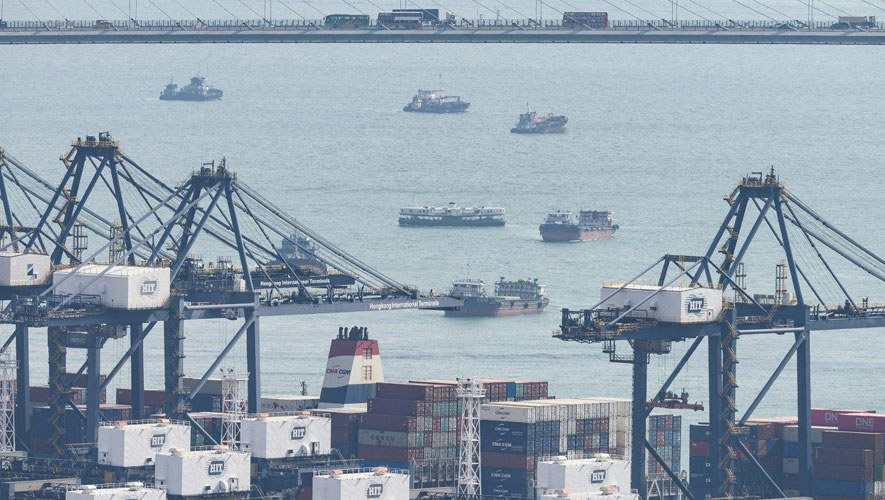A dilemma for the global economy of slower growth and low inflation
For the latest Cambodian Business news, visit Khmer Times Business
Observing the trend over the past few years, the current global economy has stepped into a slower growth and low inflation stage.
Central banks from countries around the world have loosened their controls on currencies, while zero interest and negative interest measures have become the new trend of international currency market.
This has caused a lot of people to think the world economy is being “Japanified”. If we observe what is happening in Europe and Japan currently, it seems that this is the fact.
Both regions are maintaining low interest rate and low economic growth for a long period of time. With the low inflation rate of the US, the impact of tax reduction is wearing off.
With the third rate cut of the Federal Reserve this year, the US seems to be following Japan’s footsteps.
There is speculation that China’s continuous slow economic growth is down to current global economic downturn and overcapitalization, notwithstanding the US trade war.
Currency stimulation
The characteristics of “Japanification” policy are, large-scale but in effective currency stimulation, which pushes down bond yield, and simultaneously tremendously inflates debt burden.
An analysis by Morgan Stanley discussed that, the symptom of expansion of “Japanification” is the increase in scale of negative yield rate bond.
There are signs showing that rate of increment has accelerated recently. Data indicates that 40 percent of global wealth has been exposed to a negative interest rate environment.
Among all, the bonds with negative global effective rate of return, with a total value of $20 trillion, occupy a third of the total bonds issued.
The issuing of global debt has in fact got out of hand since the 2008 global financial crisis.
A report by the Institute of International Finance (IIF) indicates that, as of the first half of last year, the scale of global debt surged from $7.5 trillion to $250 trillion.
China and the US occupied 60 percent of the new debt.
Under the long-term environment of low interest, it is expected that global debt will reach a historical high of $255 trillion.
These situations indicate that global economy is moving towards the “black hole” of Japanification”, which means that it is experiencing slow growth, low inflation, low interest rate and high debt.
Is the loose “Japanification” policy effective?
‘Lost 20 years’
In fact, from 2001 onwards, Japan has maintained low interest and loosened its currency controls.
To a certain extent, this has affected its economic growth.
However, countries around the world are following Japan’s footsteps to implement the similar policy, soon after Japan’s implementation.
Furthermore, they are still maintaining low interest currently.
Huge efforts
The Bank of Japan has made huge efforts to increase its inflation and the results have come to a conclusion that the rate of inflation could not be established through resorting to policy manoeuvre.
This matter is disrupting the major economies’ currency policy law makers, such as those of the European Central Bank and the US Federal Reserve.
Observing the “lost 20 years” of the Japanese economy and the history and evolution of 2008 Global Financial Crisis, quantitative easing (QE – printing more money) is effective in preventing the collapse of the financial system.
Toughest time
While this is absolutely true, in reality it is the end of the influence of loose monetary policy.
After the toughest time of financial crisis, with the second round and third round implementation of quantitative easing, the consecutive easy-money policy has limited impact towards economic growth and inflation.
On the other hand, currency depreciation because of monetary easing policy will probably take effect.

Currency flooding
However, not all countries’ currencies depreciate at the same time.
The easing of global currencies will only lead to currency flooding, as well as a “currency cold war” in different countries.
With this, all countries will eventually move towards zero interest rates.
With long-term low interest rates, companies with low effectiveness will survive and this means the potential economic growth rate will decrease.
Subsequently, the natural interest rate will decline and the central banks will have to follow in the footsteps of natural interest rates.
This mechanism is taking place right now and it is the result of the “Japanification” of the global economy.
Capital market bubble
Although central banks in many countries are aware that overly lenient monetary policy could no longer play the role of stimulating economic growth. However, the continuous economic downturn has caused policy makers getting even more difficult to get rid of persistent dependency on these policies.
Ever since The Federal Reserve withdrew from QE after the 2009 financial crisis, it has attempted to implement the “normalisation process of monetary policy”.
However, under the dual pressure of capital market and US government, the Fed had no choice but to implement US President Trump’s policy. This is to prevent the burst of the capital market’s bubble because of the implementation of loose monetary policy.
Stimulate growth
The Bank of Japan also attempted to interfere with the long term bonds market and subsequently affected long-term government bonds to further stimulate economic growth in recent years.
After 2016, the Bank of Japan has lowered down the whole yield curve through buying-in long-term government bonds and selling treasury bills.
These actions have also gained the control of long-term interest rate and forward rate.
The once publicly stated that the Bank of Japan could only get rid of deflation through gaining the control of long-term government bonds’ yield rate, that would also create a positive impact on enterprises and normal citizens, as well as real interest rates.
However, the end result was not favourable.
The Bank of Japan could not win in “competition” with market interest rates and failed to achieve the goal of a 2 percent inflation rate.
Obviously, with the implementation of a loose economic model, policy with positive economic growth through relying on structural currency realignment would not be effective.
It is not that easy to give up the “Japanification” policy.
Extrication not easy
The phenomena of “Japanification” indicates that, no matter which macro-economic policy (monetary policy or financial policy) is implemented, at the end of the day, it is subject to the limitation of intrinsic growth rate.
Therefore, it is extremely important to improve productivity.
Some Japanese experts have made some conclusions about the “Japanification” policy.
Skow progress
Japan has mistakenly placed resolving deflation as its top priority and the country is also having slow progress in increasing its own gross domestic product (GDP).
While implementing the policy, Japan has overly relied on loose monetary policy.
However, it is not easy to get out from this situation.
First, in terms of incremental income and cost, the decision to go for loose monetary policy implementation is more reasonable.
However, after detailed calculation of income and cost, the reasoning of “overly relying on loose monetary policy” is no longer valid.
‘Zero-sum game’
Second, the implementation of loose monetary policy in the US is more effective than any other countries in the world.
This has reflected the predominance of US dollars.
Because of this, even if this is a worldwide “zero-sum game”, the US will still insist on the implementation of a loose monetary policy.
Trade-protectionism
Third, with the anti-globalisation of populism and the rise of trade protectionism, it will be getting harder to solve the problems that arise from structural changes.
For China, we hasve previously pointed out that it will still be having the problem of low interest rates and zero interest rates, even though the world is facing an excess liquidity problem.
Because of this, The Central Bank of China is under internal and external pressure to stabilise its monetary policy.
‘Thirst-appeasing’
Most small and medium enterprises are still lacking financial support because of the obstruction of the monetary transmission mechanism and credit classification and experiencing the strong demand of “loosening” and “thirst appeasing”.
On the other hand, under the situation of competitiveness depreciation of global currencies, it may bring the pressure of large-scale capital inflows and the losing of competitiveness to physical enterprises.
Room for improvement
According to Hu Yifan, the chief China economist of the wealth management division of UBS, there is a need to get to know more about leveraging.
As we can see, there is still room for improvements in China’s monetary policy, which requires us to consider the balance between short-term fluctuations and long-term benefits.
Of course, as mentioned previously, we could not solely rely on monetary policy.
It requires the integration of other microscopic policies, adhering to structural reforms on the supply side and solving the problem of agility and effectiveness because of chronic growth of economy on the other side.
More obvious
The sign of the “Japanification” of the global economy and monetary policies is getting more obvious.
Many people have come to realise that excessive monetary easing policies are no longer able to fuel economic growth.
However, it is not easy to terminate the “Japanification” policies.
This is a dilemma for the current monetary policies.
As for China, the balance between short-term and long-term monetary policies should be considered as well.
Wei Hongxu graduated from the School of Mathematics at Peking University with a Ph.D. in economics from the University of Birmingham, in the UK, in 2010, and is a researcher at Anbound Consulting, an independent think tank with headquarters in Beijing. Anbound was established in 1993 andspecializes in public policy research.
The founder of Anbound Think Tank is Chen Gong. He is now Anbound chief researcher. Chen is one of China’s renowned experts in information analysis. Most of his outstanding academic research activities are in economic information analysis, particularly in the area of public policy.




